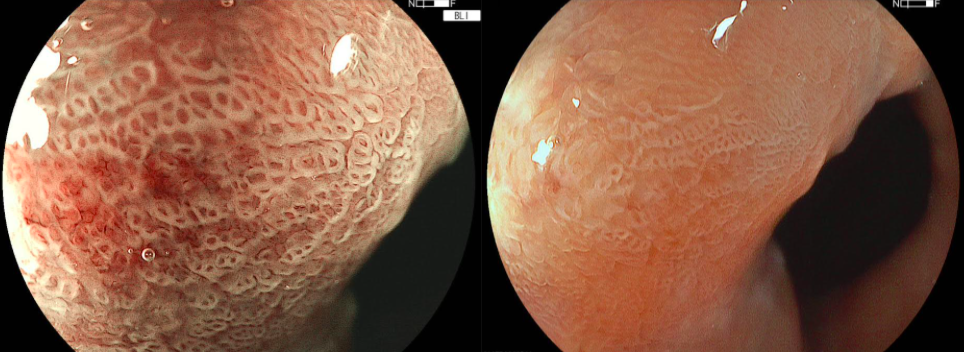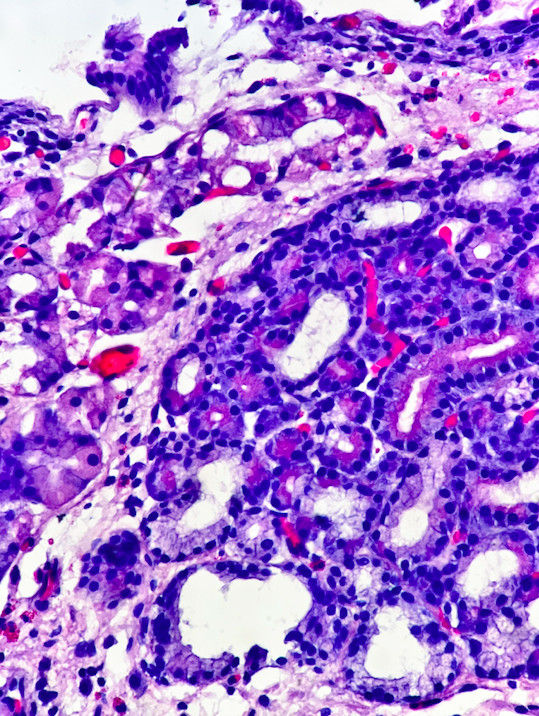Sunday Poster Session
Category: General Endoscopy
P0890 - Pancreatic Heterotopia With Rare Morphology in a Rare Location: The Gastric Cardia
Sunday, October 26, 2025
3:30 PM - 7:00 PM PDT
Location: Exhibit Hall
- PG
Priscilla M. Guerrero-Camarena, MD (she/her/hers)
Centro de Gastroenterologia Avanzada
Santo Domingo, Distrito Nacional, Dominican Republic
Presenting Author(s)
Priscilla M. Guerrero-Camarena, MD1, Dalina Martinez-Rodriguez, MD1, Pablo Socias-Pappaterra, MD2, Cynthia Contreras, MD3, Fernando Contreras, MD, FACG1, Carlos J. Esteva, 4
1Centro de Gastroenterologia Avanzada, Santo Domingo, Distrito Nacional, Dominican Republic; 2Department of Knowledge Management and Epidemiology, Centros de Diagnóstico y Medicina Avanzada y de Conferencias Médicas y Telemedicina (CEDIMAT), Santo Domingo, Dominican Republic., Santo Domingo, Distrito Nacional, Dominican Republic; 3University of Kansas Medical Center, Kansas City, KS, Kansas City, KS; 4ESTEVA Patologia, Santo Domingo, Distrito Nacional, Dominican Republic
Introduction: Pancreatic heterotopia is an incidental finding characterized by the presence of ectopic pancreatic tissue outside its normal anatomical location. Its etiology remains unknown, although it is believed to arise from embryological developmental abnormalities. It is usually asymptomatic, but can present with heartburn, nausea, dyspepsia, diarrhea, weight loss, and gastrointestinal bleeding. Ectopic pancreatic tissue has been previously observed in the antrum, duodenum, jejunum, meckel's diverticulum, ileum, and gallbladder. Its presence in the gastric cardia is atypical, with only one case documented. This report describes a 78-year-old male with findings of pancreatic heterotopia in the gastric cardia, exhibiting a different macroscopic appearance from previously reported cases.
Case Description/
Methods: A 78-year-old male with no significant past medical history presented with a 4-month history of dyspepsia, described as “postprandial fullness and sensation of delayed gastric emptying”. He denied other associated gastrointestinal symptoms, and the physical examination was unremarkable. An esophagogastroduodenoscopy was performed for further evaluation, during which a 2 cm flat lesion, metaplastic in nature, embedded within a background of active chronic gastritis, was visualized in the gastric cardia. This lesion demonstrated an increased glandular density with foveolar architecture and opacity suggestive of metaplastic replacement and was biopsied for further workup. Histopathology revealed mild chronic gastritis, atrophic changes, and small foci of pancreatic heterotopia. No other findings were reported.
Discussion: Pancreatic heterotopia is an exceptional finding that gives rise to many uncertainties. Since it can be found incidentally, accurate diagnosis is essential to avoid unnecessary interventions, emphasizing the importance of proper recognition and documentation of the lesion. In this case, the pancreatic heterotopia was found in a rare location and showed a macroscopic appearance that differed from typical descriptions in the literature. In order to determine whether pancreatic heterotopia should be included in the differential diagnosis of patients with dyspepsia or related symptoms, further long-term follow-up studies are recommended.

Figure: Figure 1. A 2 cm flat lesion with increased glandular density and foveolar architecture , metaplastic in nature, embedded within a background of active chronic gastritis

Figure: Figure 2. Gastric biopsy showing a focus of pancreatic heterotopia composed of exocrine acinar structures and some ductal structures, without atypia, consistent with pancreatic tissue (H&E, 200x). Type II Heterotopia based on the Heinrich and Gaspar-Fuentes Classification.
Disclosures:
Priscilla Guerrero-Camarena indicated no relevant financial relationships.
Dalina Martinez-Rodriguez indicated no relevant financial relationships.
Pablo Socias-Pappaterra indicated no relevant financial relationships.
Cynthia Contreras indicated no relevant financial relationships.
Fernando Contreras indicated no relevant financial relationships.
Carlos Esteva indicated no relevant financial relationships.
Priscilla M. Guerrero-Camarena, MD1, Dalina Martinez-Rodriguez, MD1, Pablo Socias-Pappaterra, MD2, Cynthia Contreras, MD3, Fernando Contreras, MD, FACG1, Carlos J. Esteva, 4. P0890 - Pancreatic Heterotopia With Rare Morphology in a Rare Location: The Gastric Cardia, ACG 2025 Annual Scientific Meeting Abstracts. Phoenix, AZ: American College of Gastroenterology.
1Centro de Gastroenterologia Avanzada, Santo Domingo, Distrito Nacional, Dominican Republic; 2Department of Knowledge Management and Epidemiology, Centros de Diagnóstico y Medicina Avanzada y de Conferencias Médicas y Telemedicina (CEDIMAT), Santo Domingo, Dominican Republic., Santo Domingo, Distrito Nacional, Dominican Republic; 3University of Kansas Medical Center, Kansas City, KS, Kansas City, KS; 4ESTEVA Patologia, Santo Domingo, Distrito Nacional, Dominican Republic
Introduction: Pancreatic heterotopia is an incidental finding characterized by the presence of ectopic pancreatic tissue outside its normal anatomical location. Its etiology remains unknown, although it is believed to arise from embryological developmental abnormalities. It is usually asymptomatic, but can present with heartburn, nausea, dyspepsia, diarrhea, weight loss, and gastrointestinal bleeding. Ectopic pancreatic tissue has been previously observed in the antrum, duodenum, jejunum, meckel's diverticulum, ileum, and gallbladder. Its presence in the gastric cardia is atypical, with only one case documented. This report describes a 78-year-old male with findings of pancreatic heterotopia in the gastric cardia, exhibiting a different macroscopic appearance from previously reported cases.
Case Description/
Methods: A 78-year-old male with no significant past medical history presented with a 4-month history of dyspepsia, described as “postprandial fullness and sensation of delayed gastric emptying”. He denied other associated gastrointestinal symptoms, and the physical examination was unremarkable. An esophagogastroduodenoscopy was performed for further evaluation, during which a 2 cm flat lesion, metaplastic in nature, embedded within a background of active chronic gastritis, was visualized in the gastric cardia. This lesion demonstrated an increased glandular density with foveolar architecture and opacity suggestive of metaplastic replacement and was biopsied for further workup. Histopathology revealed mild chronic gastritis, atrophic changes, and small foci of pancreatic heterotopia. No other findings were reported.
Discussion: Pancreatic heterotopia is an exceptional finding that gives rise to many uncertainties. Since it can be found incidentally, accurate diagnosis is essential to avoid unnecessary interventions, emphasizing the importance of proper recognition and documentation of the lesion. In this case, the pancreatic heterotopia was found in a rare location and showed a macroscopic appearance that differed from typical descriptions in the literature. In order to determine whether pancreatic heterotopia should be included in the differential diagnosis of patients with dyspepsia or related symptoms, further long-term follow-up studies are recommended.

Figure: Figure 1. A 2 cm flat lesion with increased glandular density and foveolar architecture , metaplastic in nature, embedded within a background of active chronic gastritis

Figure: Figure 2. Gastric biopsy showing a focus of pancreatic heterotopia composed of exocrine acinar structures and some ductal structures, without atypia, consistent with pancreatic tissue (H&E, 200x). Type II Heterotopia based on the Heinrich and Gaspar-Fuentes Classification.
Disclosures:
Priscilla Guerrero-Camarena indicated no relevant financial relationships.
Dalina Martinez-Rodriguez indicated no relevant financial relationships.
Pablo Socias-Pappaterra indicated no relevant financial relationships.
Cynthia Contreras indicated no relevant financial relationships.
Fernando Contreras indicated no relevant financial relationships.
Carlos Esteva indicated no relevant financial relationships.
Priscilla M. Guerrero-Camarena, MD1, Dalina Martinez-Rodriguez, MD1, Pablo Socias-Pappaterra, MD2, Cynthia Contreras, MD3, Fernando Contreras, MD, FACG1, Carlos J. Esteva, 4. P0890 - Pancreatic Heterotopia With Rare Morphology in a Rare Location: The Gastric Cardia, ACG 2025 Annual Scientific Meeting Abstracts. Phoenix, AZ: American College of Gastroenterology.
